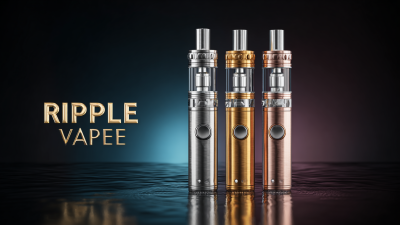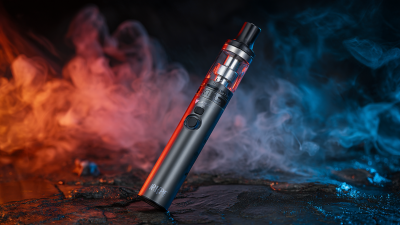
As the vaping industry continues to expand, Ripple Vape has emerged as a popular alternative for those seeking a diverse range of flavors and potentially less harmful options compared to traditional smoking. However, understanding the health benefits and risks associated with Ripple Vape is crucial for consumers who are increasingly concerned about their well-being. Dr. Emily Stanton, a leading expert in vaping research, emphasizes, "While Ripple Vape may offer some advantages, particularly in flavor and discretion, it’s essential for users to be aware of the potential health implications."
In this exploration, we delve into the various aspects of Ripple Vape, including its formulation, user experiences, and the scientific consensus surrounding its impact on health. Proponents argue that Ripple Vape can be a safer alternative for those looking to reduce nicotine intake, but critics raise concerns about the lack of long-term studies and the presence of certain chemicals that could pose risks. By examining both sides of the debate, we aim to provide a comprehensive overview of what consumers need to know before making a decision about incorporating Ripple Vape into their lifestyle.

Ripple vape is a relatively new product in the world of vaping, designed to deliver a unique experience through its innovative composition. At its core, ripple vape utilizes a blend of cannabinoids, typically derived from hemp, which can include CBD, THC, and other beneficial compounds. This formulation sets it apart from traditional vaping products, as it aims to provide a more balanced effect without the harshness often associated with nicotine vaping. The inclusion of terpenes further enhances the flavor profile while potentially boosting the therapeutic effects, making ripple vape an appealing choice for those seeking both enjoyment and wellness.
Functionally, ripple vape operates using a vaporization process that heats the liquid to a temperature just below combustion, allowing users to inhale a mist rather than smoke. This method not only reduces harmful byproducts but also enables a more controlled dosage of cannabinoids. Users can choose from various flavors and strengths, catering to individual preferences and desired effects. Moreover, the portability and discreet nature of ripple vape devices make them convenient for on-the-go use, attracting a diverse range of consumers from wellness enthusiasts to casual users. Understanding these aspects is essential for anyone considering incorporating ripple vape into their lifestyle.
Ripple Vape has gained popularity among users looking for an alternative to traditional methods of consuming cannabinoids. One of the potential health benefits of using Ripple Vape lies in its formulation, which often includes natural terpenes and cannabinoids without the harmful tar and toxins associated with smoking. Many users report experiencing a faster onset of effects and enhanced flavors, making it a more enjoyable option for those seeking therapeutic benefits.
Additionally, Ripple Vape offers convenience and discreet use, appealing to individuals who prioritize their health and lifestyle. The precision dosing available in some Ripple Vape products allows users to tailor their experiences, minimizing the risk of overconsumption while promoting controlled environments for relaxation and relief. By providing a potentially less harmful method of consumption, Ripple Vape may be a suitable option for those looking to explore the health benefits associated with cannabinoids without the negative consequences typically associated with smoking.
Ripple vape, like many other vaping products, poses certain health risks that users should be aware of. One of the main concerns is the presence of potentially harmful chemicals often found in vape liquids. While some manufacturers claim their products are free from substances like formaldehyde and diacetyl, the lack of regulation means that users cannot always trust these assertions. Inhalation of these chemicals can lead to respiratory issues and other long-term health complications.
Additionally, the use of flavored vape products, such as those offered by Ripple, can attract younger consumers, leading to increased nicotine addiction rates among this demographic. Nicotine itself is associated with a range of health risks, including increased heart rate, elevated blood pressure, and heightened susceptibility to mood disorders. Furthermore, there are ongoing debates about the potential for serious health events, such as lung injuries linked to vaping, which have been reported by various health authorities. These factors highlight the importance of understanding the risks before choosing to use Ripple vape products.
The debate surrounding the health impacts of vaping compared to traditional smoking methods has gained significant attention in recent years. While e-cigarettes are often marketed as a safer alternative to combustible tobacco products, emerging research suggests that they may not be as benign as initially claimed. For instance, a recent study from a British university highlighted that vaping can cause lung cell damage comparable to that of smoking traditional cigarettes. This raises concerns about the long-term implications of e-cigarette use on respiratory health.
Additionally, findings from various health organizations indicate that while e-cigarettes do not produce tar like traditional cigarettes, they still expose users to harmful substances. A report from Public Health England previously suggested that vaping is around 95% less harmful than smoking; however, this assessment may overlook the potential risks associated with inhaling vaporized substances. Reports of adverse reactions among young adults who used vapes further underscore the need for caution. For example, incidents involving students experiencing dizziness and anxiety after using e-cigarettes serve as a stark reminder that the health consequences of vaping should not be underestimated.
| Aspect | Ripple Vape | Traditional Smoking |
|---|---|---|
| Health Benefits | Lower levels of harmful toxins | Contains tar and numerous carcinogens |
| Nicotine Delivery | Varied levels available; can be lower than cigarettes | Typically high nicotine content |
| Additives and Flavors | Wide range of flavors; some may contain additives | Limited flavors; primarily tobacco |
| Secondhand Exposure | May produce less smoke | High levels of harmful secondhand smoke |
| Addiction Potential | Can be addictive due to nicotine | Highly addictive due to high nicotine levels |
| Long-term Health Risks | Unknown; ongoing research | Well-documented health risks (cancer, respiratory issues) |
| Public Perception | Generally viewed as a safer alternative | Increasingly viewed negatively |
When considering the use of Ripple Vape, it’s essential to follow specific guidelines to maximize health benefits while minimizing risks. First and foremost, users should begin with a low dosage to assess their individual tolerance levels. Gradually increasing the amount allows for better understanding of how Ripple Vape interacts with your body, ensuring a more tailored experience. Additionally, staying well-hydrated and maintaining a balanced diet can help mitigate potential side effects, promoting overall wellness during usage.
Equally important is being mindful of the environment in which Ripple Vape is used. Opting for well-ventilated areas reduces exposure to concentrated vapor, which can benefit both the user and those nearby. It's also advisable to avoid combining Ripple Vape with other substances, as this can lead to unpredictable effects. Lastly, maintaining open communication with healthcare providers about your vaping habits can provide valuable insights into its impacts on personal health, enabling informed decisions and fostering responsible use.






